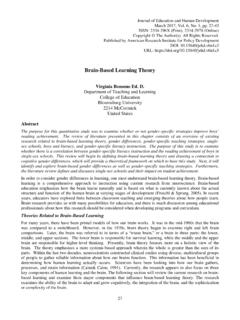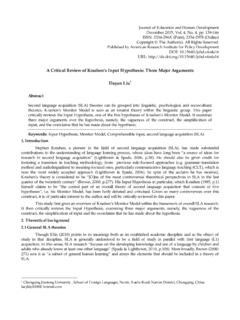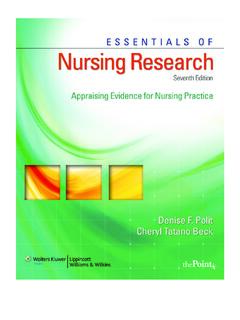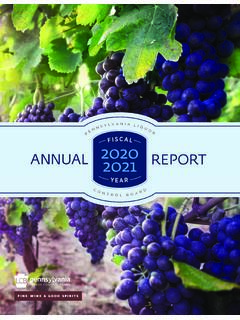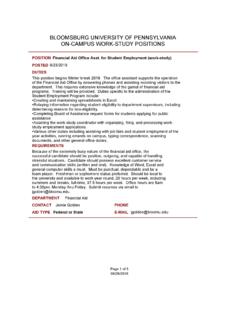Transcription of Ability Grouping is on the Rise, but Should It Be ...
1 Journal of Education and Human Development June 2016, Vol. 5, No. 2, pp. 40-51 ISSN: 2334-296X (Print), 2334-2978 (Online) Copyright The Author(s). All Rights Reserved. Published by American Research Institute for Policy Development DOI: URL: Ability Grouping is on the Rise, but Should It Be? Kristina N. Bolick, & Beth A. Rogowsky, Abstract Ability Grouping is on the rise in American schools. Teachers engage in this classroom organizational strategy with the purpose of meeting individual learners needs, improving student learning, and increasing test scores. However, there is opposition to Ability Grouping . Teachers who do not practice Ability Grouping often question its significance, believe it has a negative outcome on student achievement and self-concept, or prefer teaching whole-group instruction. This review of the research literature sought to determine the effectiveness of Ability Grouping on kindergarten through sixth grade students.
2 Specifically, this review examined what Ability Grouping encompasses and the varying methods for implementing Ability Grouping at the elementary level. In addition, we investigated the effect of Ability Grouping on the academic achievement of advanced, on level, and below level elementary students. Finally, we explored how Ability Grouping influences the psychological and social welfare of young students. Key Words: Ability Grouping , elementary students, between-class Ability Grouping , within-class Ability Grouping 1. Introduction Many educators of elementary school children have practiced at least one form of Ability Grouping during their tenure in the classroom. In the 2013 Brown Center Report on American Education, Loveless reported that from 1998 to 2009 the percentage of fourth-grade teachers implementing Ability -based reading groups increased from 28% to 71%.
3 In that same report, Loveless reported an increase in math Ability Grouping from 40% to 61% from 1996 to 2011. These findings demonstrate that Ability Grouping is on the rise in American classrooms. Teachers engage in this classroom organizational strategy with the purpose of meeting individual learners needs, improving student learning, and increasing test scores. Teachers who do not practice Ability Grouping often question its significance, believe it has a negative outcome on student achievement and self-concept, or prefer teaching whole-group instruction. Missett, Brunner, Callahan, Moon, and Azano (2014) found that teacher beliefs and expectations about their students abilities influence the instructional choices made in the classroom. Significant instructional decisions like Ability Grouping Should not be based on conjecture, but by empirical research that provides administrators and educators alike with the knowledge to determine whether Ability Grouping is an effective instructional practice to implement school wide and/or in individual classrooms for elementary students.
4 The purpose of this review is to determine the effectiveness of Ability Grouping on kindergarten through sixth grade students. A comprehensive analysis will be presented through the use of three guiding research questions. First, what is Ability Grouping and how is Ability Grouping implemented at the elementary level? Second, what is the effect of Ability Grouping on the academic achievement of advanced, on level, and below level elementary students? Finally, how does Ability Grouping influence the psychological and social welfare of students? 1 College of Education, 2213 McCormick Center, bloomsburg university of pennsylvania , bloomsburg , PA 17815, USA. 2 College of Education, 2213 McCormick Center, bloomsburg university of pennsylvania , bloomsburg , PA 17815, USA. Telephone: 570-389-4998 (office) 570-594-6644 (cell); FAX: 570-39-3848; Email: Bolick & Rogowsky 41 2.
5 What Is Ability Grouping and How Is It Implemented at the Elementary Level? Ability Grouping is an educational approach that places students in groups based on academic achievement. The common purpose of Ability Grouping is to provide instruction that is appropriate for students and their individual needs. The two most common forms of Ability Grouping are between-class and within-class Ability Grouping . Between-class Ability Grouping is the practice of separating students into different classrooms based on academic Ability or past performance (Matthews, Ritchotte, & McBee, 2013). Whereas, within-class Ability Grouping divides students within a class based on academic Ability , past performance, or student interests. These groups are typically assigned by the teacher and may be heterogeneous or homogeneous. It is the intent for Ability Grouping assignments to be flexible, which means that students can easily move in and out of Grouping assignments based on performance.
6 Between-class Ability Grouping : Between-class Ability Grouping has many variations that are practiced throughout elementary schools. Researchers have studied different styles of between-class Ability Grouping such as multilevel classes (Gentry & MacDougall, 2009; Kulik & Kulik, 1992; Tieso, 2003), cross-grade Grouping (Kulik & Kulik, 1992; Tieso, 2003), school-wide cluster Grouping (Brulles, Peters, & Saunders, 2012; Gentry & MacDougall, 2009;Matthews et al., 2009), total-school cluster Grouping (Gentry & Owen, 1999; Gentry & MacDougall, 2009), and tracking (Gentry & MacDougall, 2009; Matthews et al., 2009; Worthy, 2010). a. Multi-level Ability Grouping : Multilevel Ability Grouping is the practice of dividing students of the same grade into groups based on Ability or for a specific subject. When multilevel Ability Grouping was first introduced in Detroit in 1919, standard materials, and methods were used without the differentiation of curriculum or instruction between groups (Kulik & Kulik, 1992).
7 In other words, students received the same content; the only difference was that they were among a classroom full of peers with similar abilities. This style of multilevel class typically had little or no effect on student achievement (Kulik & Kulik, 1992). A more common example now seen in elementary schools is the regrouping of students for a particular subject area based on achievement or Ability , which includes a variety of curriculum, materials, and strategies for diverse learners (Gentry & MacDougall, 2009). When this occurs, the instruction is designed to meet the comparable needs of the students. Teachers use relevant curricula, appropriate pace, and suitable approaches to promote successful learning (Gentry & MacDougall, 2009). In the case with mathematics, one teacher teaches algebra to a classroom of high- Ability advanced students, another teaches pre-algebra to proficient students, all the while another teacher instructs struggling students on the basics and fundamentals of math.
8 As students advance or decrease in their academic achievement and learning, they have the opportunity to move in and out of classrooms, which are referred to as flexible Ability Grouping (Matthews et al. 2009). b. Cross-grade Grouping : Cross-grade Grouping is similar to multilevel Grouping , except it includes students of various grades and typically involves more achievement levels and classes (Kulik & Kulik, 1992). According to Tieso (2003), the most well known cross-grade Grouping assignment is the Joplin Plan. The Joplin Plan initially started by cross-grade Grouping elementary students in reading. Students in different grades would separate into different classrooms for reading instruction appropriate to their readiness levels and return to the regular education classroom for the remainder of the day (Tieso, 2003).
9 The teachers would instruct using textbooks and materials that were relevant to the students abilities and not their specific grade levels. This enables teachers to adapt the curriculum and instruction to meet the similar needs of the group, rather than having a classroom full of students of various abilities using a variety of materials (Tieso, 2003). The Joplin Plan later evolved to include rearrangement for math instruction as well. c. School-wide cluster Grouping : School-wide cluster Grouping is described as the placement of high achieving or gifted students in a regular education classroom (Gentry & MacDougall, 2009). One purpose of this arrangement is to establish an equalized range of achievement levels in a classroom and limit extreme variations of student abilities (Brulles et al., 2012). The classroom teacher differentiates the curriculum and instruction for all abilities while teaching.
10 This type of between-class Grouping has shown effective results in meeting the academic needs of high-achieving students as well as students of other levels (Gentry & MacDougall, 2009). 42 Journal of Education and Human Development, Vol. 5(2), June 2016 d. Total school cluster Grouping : Total school cluster Grouping is a specific type of cluster between-class Grouping . In this model, students are categorized based on achievement levels and given a placement for the school year (Matthews et al., 2013). Students are placed in categories such as high achieving, above average, average, low average, low, and special education (Matthews et al., 2013). Similar to school-wide cluster Grouping , teachers may change categorical assignments as students achievement levels increase or decrease (Matthews et al.)

